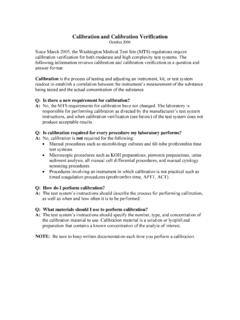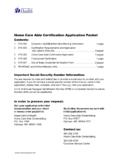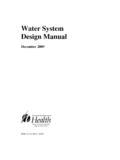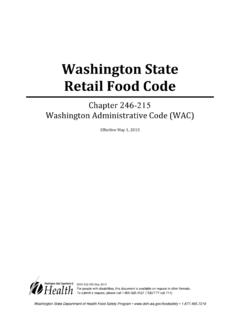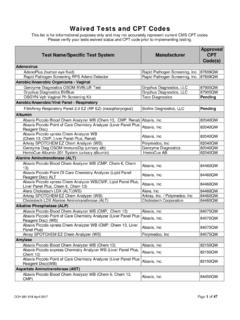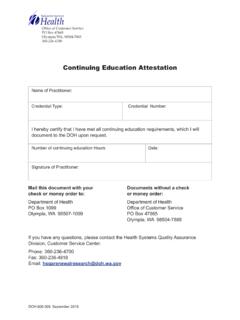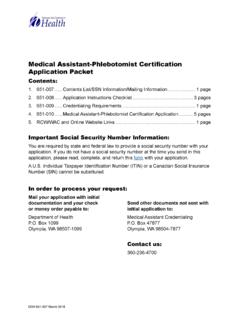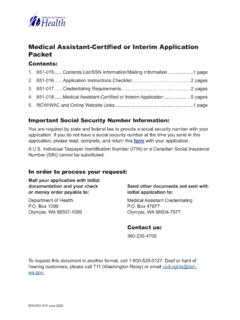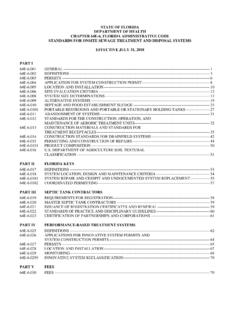Transcription of Wastewater Quality / Strength / and Content
1 washington State department of health Wastewater Management Program RULE DEVELOPMENT COMMITTEE ISSUE RESEARCH REPORT. DRAFT. - Wastewater Quality / Strength / Content - DOH Staff Researchers: Laura A. Benefield Date Assigned: 12/17/01. Date Completed: 4/16/02. Research Requested by: RDC TRC Other _____. Issue Subject: Technical Issue ID __T5_____. Administrative Regulatory Definitions Specific WAC Section Reference, if WAC related: WAC 246-272-11501(3). Topic & Issues: Wastewater Quality / Strength / Content . What numerical values can be derived to define Residential Strength Wastewater for determining whether a particular source is typical domestic Strength ? What numerical values can be derived to define High Strength Wastewater for determining whether a particular source is higher than domestic Strength ?
2 Is there an existing testing protocol that can be placed into rule for High Strength Wastewater treatment systems or does one need to be developed? What are the system design criteria needed to address High Strength Wastewater ? Explore the use of appropriate design standards. Clarify the permitting of nonresidential waste streams and design requirements of nonresidential sources; dog kennels, restaurants, mini mart, etc. Summary: This report summarizes the literature on the topic of high Strength Wastewater and it's effects on on-site sewage systems. The purpose of this report is to review the literature available on the topic of high Strength Wastewater in order to determine the need to better define residential Strength Wastewater , to define high Strength Wastewater , possible alternative design criteria, and the capacity of these alternative designs to reduce high Strength Wastewater parameters.
3 This review was undertaken because application of high Strength Wastewater has been attributed to severe soil clogging to the point of hydraulic failure, anoxic soil conditions, and reduced Wastewater treatment. The accelerated rate of failures on commercial sites has led researchers to explore the cause of such failures. High concentrations of biochemical oxygen demand (BOD5), total suspended solids (TSS), and fats, oils, and greases (FOG) were indicative of these failures. The lack of clear guidance for determining and evaluating high Strength Wastewater has brought about a need for research in this area, however the research available is still quite limited. Design of on-site sewage systems currently is based on hydraulic loading rates and soil acceptance rates.
4 Hydraulic loading rates do not take into consideration the organic loading to the soil. Septic tank effluent when applied to the soil causes a clogging layer to form. This clogging layer is also known as a biomat. The clogging layer, while increasing treatment performance, reduces the infiltrative capacity of the soil. Page 1 of 18. washington State department of health Wastewater Management Program RULE DEVELOPMENT COMMITTEE ISSUE RESEARCH REPORT DRAFT. - Wastewater Quality / Strength / CONTNENT. Soil clogging is generally accelerated under increasing hydraulic loading rates or under increasing concentrations of organic matter and suspended solids. Most states have not taken high Strength Wastewater characteristics into consideration when designing on-site sewage disposal systems.
5 However, a number of states such as North Carolina, Oregon and washington are now recognizing that effluent BOD5, TSS, and FOG concentrations in excess of domestic septic tank effluent may need to be addressed. A number of pretreatment possibilities exist. To what extent these pretreatment alternatives reduce high Strength Wastewater is yet to be completely understood. The Environmental Protection Agency (EPA) and National Sanitation Foundation, International (NSF) have recently completed a testing protocol that may assist in determining treatment capacity of these pretreatment alternatives. KEYWORDS: (commercial Wastewater , high Strength Wastewater , grease and oil, mass loading rate, organic loading, residential Strength Wastewater , restaurant, soil clogging).
6 Introduction: Hydraulic loading and treatment performance have been the basis for design of on-site sewage disposal systems in this state. Treatment standards are in place specifically to address repairs and reductions in vertical and horizontal separation. These standards include limits for BOD5, TSS, and fecal coliform. Current practice does not require consideration of biological or organic loading when designing a conforming system. For non-residential sewage, the rules do however require the designer to provide information to establish the sewage Strength and identify chemicals found in the sewage that are not found in residential sewage. Research reports have concluded that high concentrations of BOD5, TSS, and FOG will contribute to increased failure rates.
7 Concentrations greater than residential Strength of these parameters will cause early failure by creation of a clogging mat in the dispersal component. When combined, effluent concentration and hydraulic loading both contribute to clogging and formation of biomat, resulting in failure (Matejcek, Erlsten & Bloomquist, 2000). Researchers agreed that pretreatment of high Strength wastewaters whether commercial or residential must be included in design to reduce these parameters. The definitions of residential Strength Wastewater and high Strength Wastewater vary throughout the research. Residential Strength Wastewater influent examples range from BOD5 100 mg/L 400 mg/L, TSS 100 400 mg/L, and FOG 50 150 mg/L. High Strength Wastewater influent examples range from BOD5 100 3685 mg/L, TSS 142 4375 mg/L, and FOG 25 14,958 mg/L.
8 Many of the researchers chose to define high Strength wastewaters as greater than residential Strength . The most commonly used residential Strength testing protocol defines residential Strength influent as BOD5 100-300 mg/L, TSS 100-350 mg/L (NSF Standard No. 40). Fats, Oils, and Greases are not addressed in this protocol. The testing protocol is specific for residential treatment units and cannot be used for high Strength Wastewater testing. The Environmental Protection Agency (EPA) in conjunction with the National Sanitation Foundation (NSF) have developed a testing protocol that would allow for high Strength Wastewater testing (NSF International, 2000). Although FOG is not included in this testing protocol, it can be added by request of the petitioner.
9 The purpose of this review is to synthesize the literature available on the topic of high Strength Wastewater so that the Technical Review Committee can make appropriate recommendations about residential Wastewater and high Strength Wastewater definitions, design requirements, and potential high Strength Wastewater testing protocols to the Rule Development Committee. More than 35 publications, which include peer, reviewed journal articles, conference proceedings and government reports were collected and reviewed. Even though the majority of the publications are conference proceedings, which are typically not peer reviewed, they provided useful information regarding the high Strength Wastewater . Page 2 of 18. washington State department of health Wastewater Management Program RULE DEVELOPMENT COMMITTEE ISSUE RESEARCH REPORT DRAFT.
10 - Wastewater Quality / Strength / CONTNENT. Residential Strength Wastewater In the washington Administrative Code (WAC), residential Wastewater means sewage having the constituency and Strength typical of Wastewater of domestic households . The WAC does not however define what those constituents and strengths are to be. The Recommended Standards and Guidance for Aerobic Treatment Units (ATUs) does define residential Strength influent (untreated domestic Wastewater ). in accordance with the National Sanitation Foundation Standard Number 40 as 100-300 mg/L CBOD5 and 100-350 mg/L TSS. FOG is only addressed in the product performance section for Category 2 ATUs (designed to treat high Strength non-residential or commercial Wastewater ) where the performance must provide an effluent (septic tank effluent) Quality equal to or less than 200 mg/L BOD5, 125 mg/L TSS, and 25 mg/L FOG.
